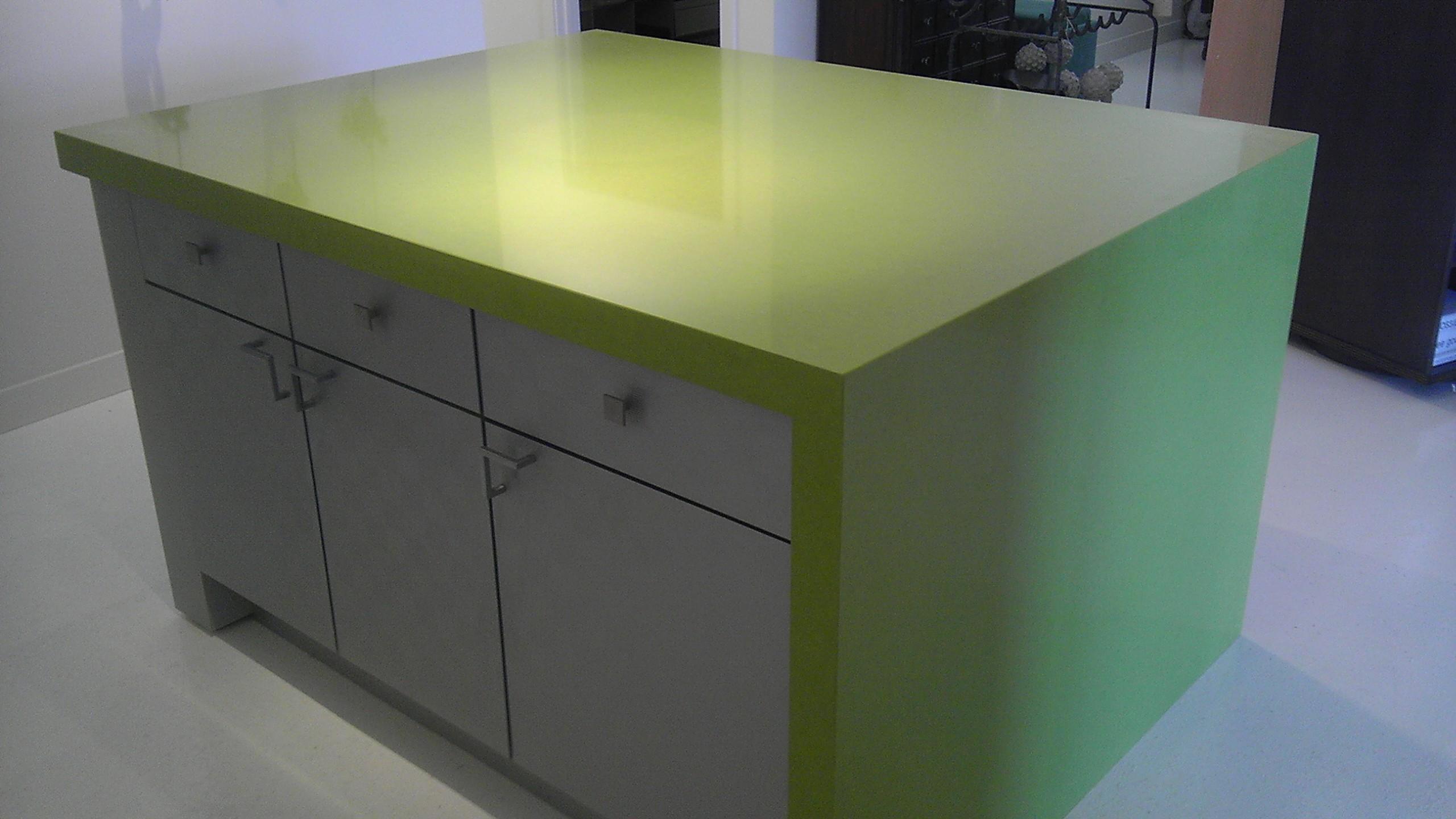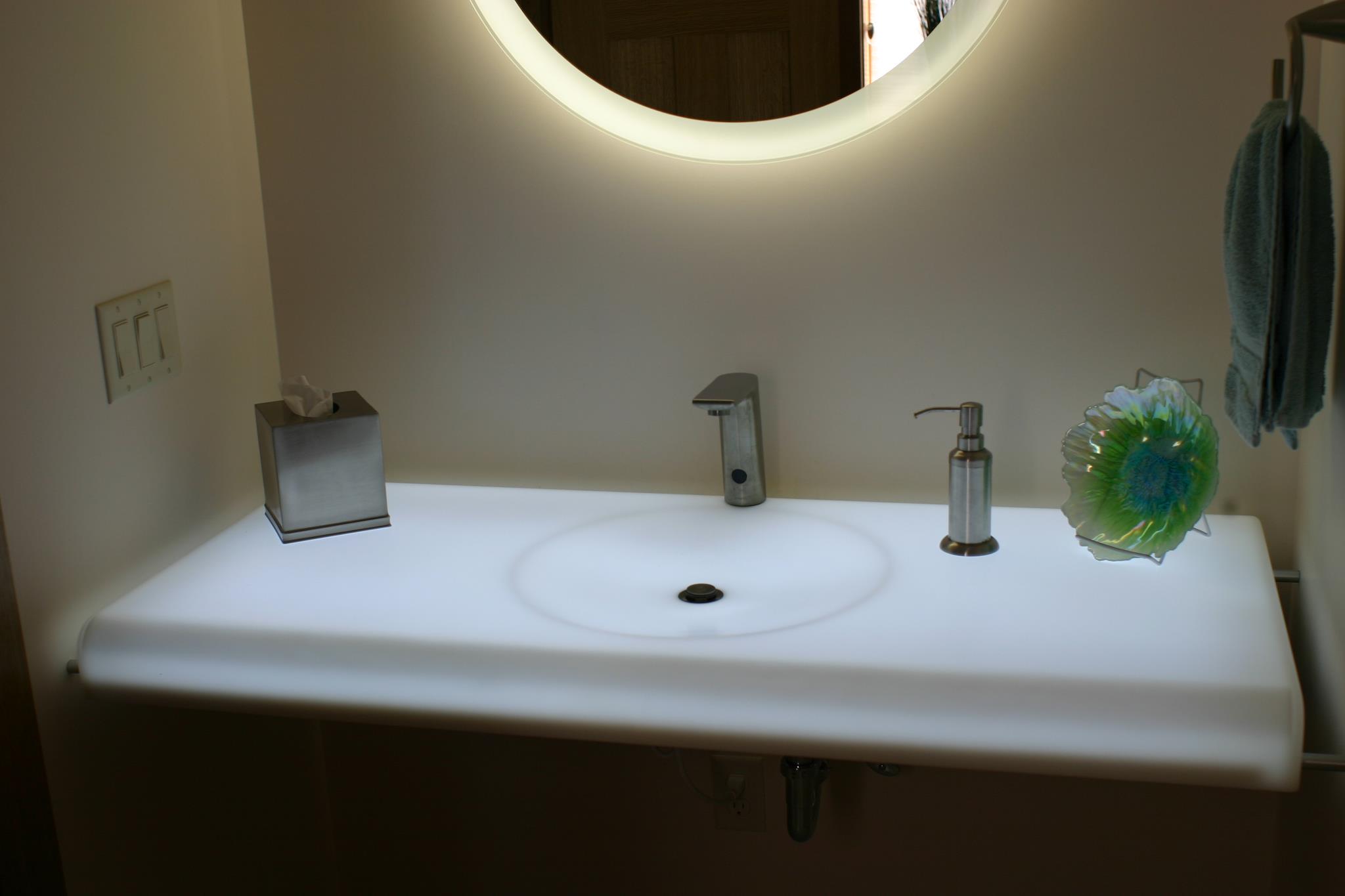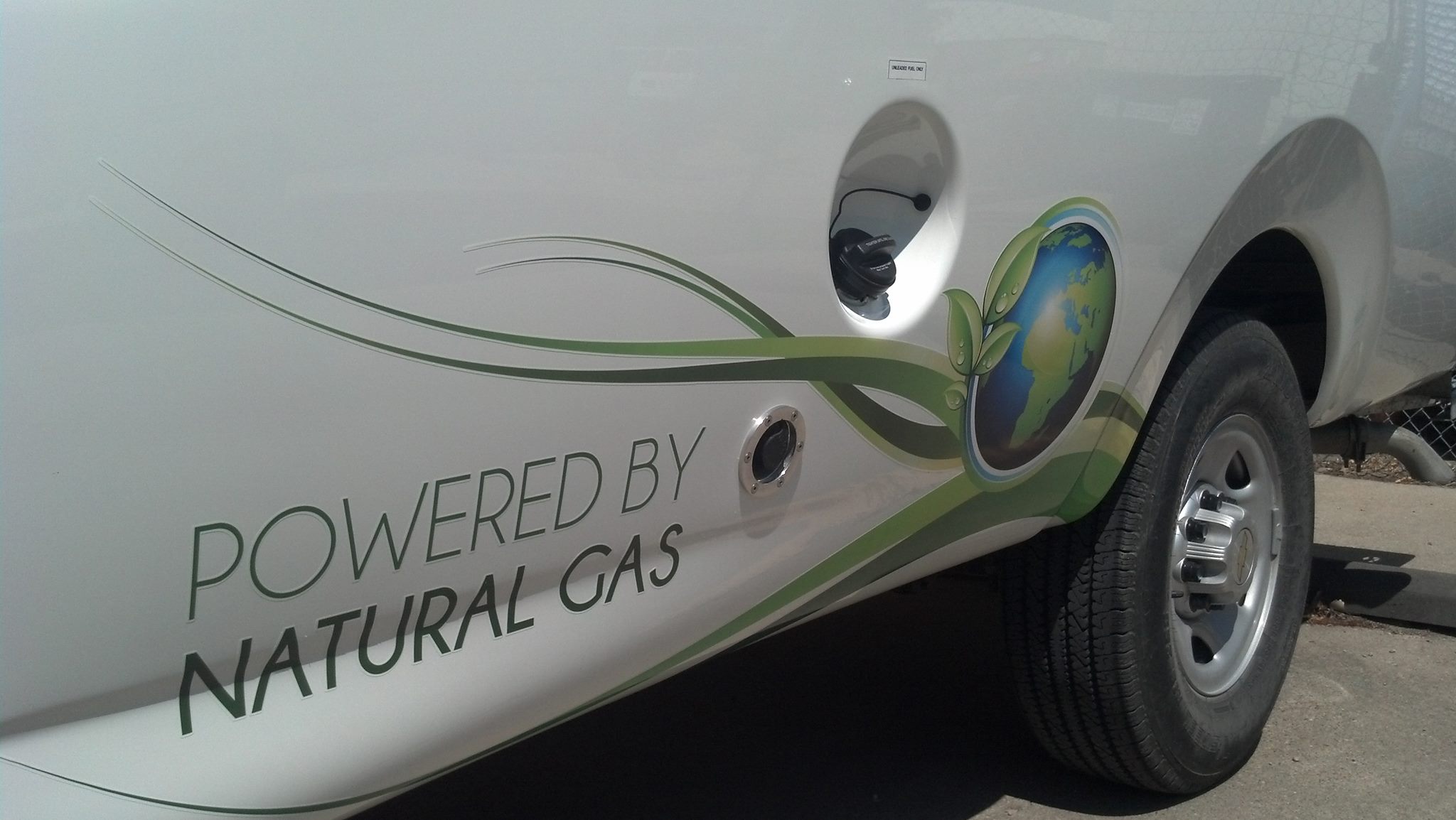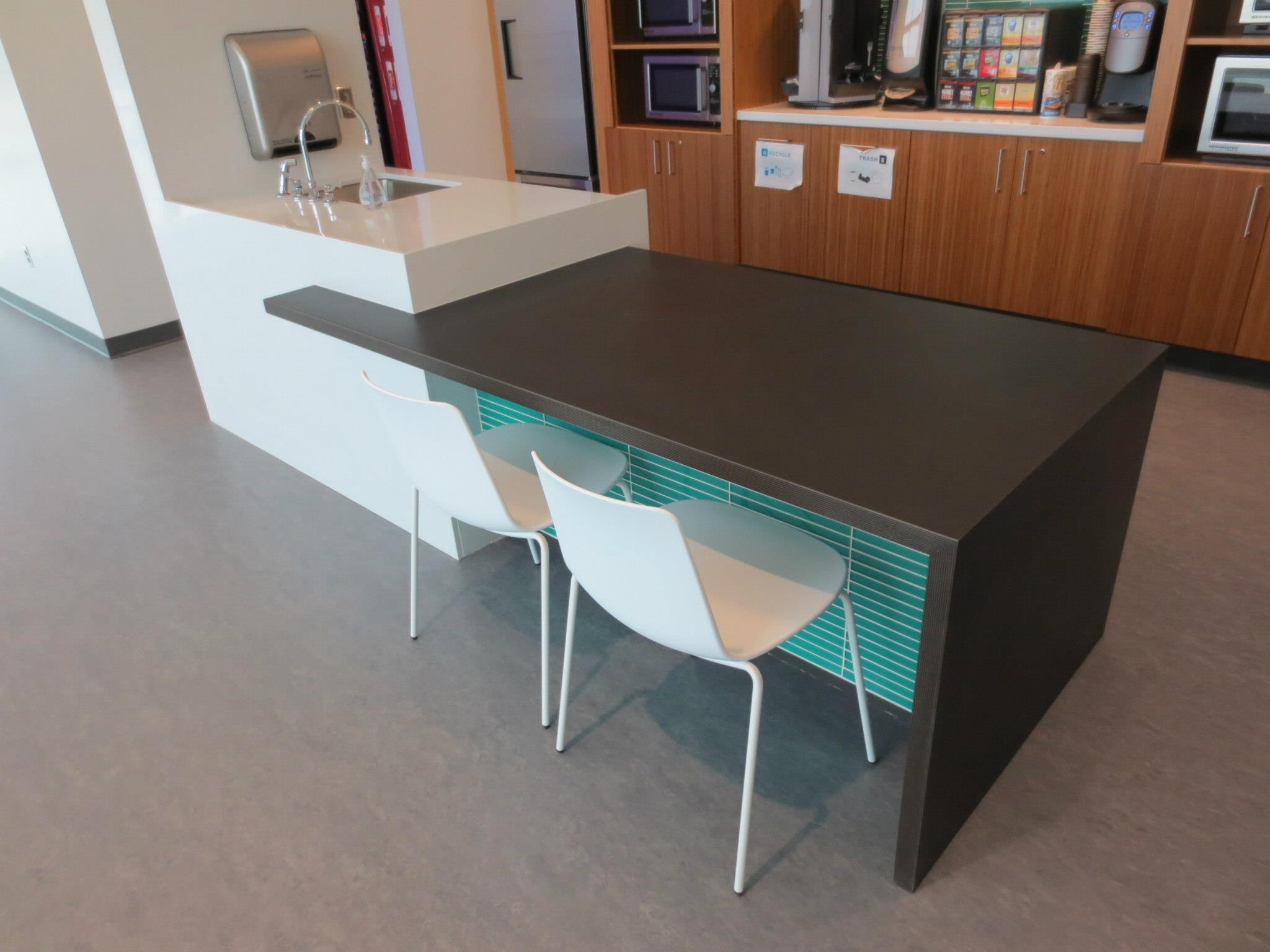Countertops Magazine ArchiveFabricator Profile: Lincoln Laminating
Lincoln Laminating was one of the first certified DuPont Corian fabricators and as such has done many non-traditional projects from solid surface, such as this bathroom which uses solid surface not only on the vanity, but also has cabinets and flooring made from solid surface. Originally founded in 1962 by Ron Biloff as a cabinet and laminate countertop fabrication shop, Lincoln Laminating Inc., in Lincoln, Neb., has come a long way since. In 1970, the company became one of the first certified DuPont Corian fabricators in the country, and although the name stuck, in the mid-90s Biloff sold the laminate portion of the business and began specializing in solid surface countertops. In 2002, Bob and Alice Wiechert purchased Lincoln Laminating and worked to grow the business. Today the company employs 25 people and works in a variety of market segments, such as the commercial arena, which accounts for more than half of its business, as well as home centers, kitchen & bath dealers, retail sales, interior designers and homebuilders. The company also expanded its product offerings. For instance, when the Wiecherts took over, the business was focused almost exclusively on the fabrication of solid surface, and only templating and installing granite and quartz surfacing, but now they fabricate any number of materials, including solid surface, quartz, granite and recycled glass products.
With the growth of popularity of quartz surfacing, in 2010 Lincoln Laminating opened a stone shop at a second location and brought its hard surface fabrication in-house. This Caesarstone ‘Apple Martini’ colored island with the full drop down on the side illustrates the interesting applications the company has been involved with since. The Company Today To accommodate the stone and quartz side of the business, Lincoln Laminating opened a second facility in Omaha, Neb., about 45 minutes away from their solid surface shop. This new facility houses their stone fabrication outfit. In addition to increasing the company’s product offering, this move also increased its footprint and the business now covers five states. “In 2013, on average, we went through about 26 slabs of granite and quartz and 80 sheets of solid surface per month,” said Albee. “Solid surface sales accounted for 71 percent of our total business in 2013.” The company also strives to take advantage of modern technology, and utilizes a panel saw, CNC router, v-groover, shaper, bridge saw, thermoforming ovens, a CNC stone fabrication machine, a digital templating system, an inline polisher, overhead cranes, dust collection equipment and numerous other modern pieces of equipment. "We recognized that the logistical side of the business in the office could be more efficient as well,” said Bob Wiechert. “By investing in project management software from Sage and Zoom Integrated Products, we have been able to do more with less, and keep better control of expenses as sales vary from month to month.”
This backlit Corian vanity with the super shallow sink basin is another example of the unique work that Lincoln Laminating tackles. The Company We Keep One cut that Albee later found to be a mistake was membership in ISFA. “We were a charter member of ISFA and left a few years ago,” he said. “The decision was largely my own. We were cutting costs and at the time I didn’t feel like we were getting good value for the expense. Over the next couple of years, though, I learned a valuable lesson: The ability to connect with other fabricators who share your passion and face the same challenges is priceless.” When Albee reached out to the industry, he found others were reaching back. “I was amazed at all of the valuable information people were willing to share that I could put to use in our business,” he explained. “I started interacting with ISFA members again and realized there is a goldmine of business knowledge within the ISFA community and we renewed our membership. As with all things, you get out what you put in. In hind-sight, the value was always there, I just wasn’t tapping into it. I can have one conversation, with one ISFA member, and more than cover the cost of membership.” It’s this type of interaction that helped Lincoln Laminating hold on to its philosophy of continuous improvement, with the objective being less chaos and more profitability. Of course, perfection is always a moving target, but Albee feels like he is closing in on that most elusive of goals.
Lincoln Laminating operates on a philosophy that takes “There’s always room for improvement,” and this is not only applied to the company’s processes but also shows in the way it takes advantage of modern technologies, such as this natural gas powered installation vehicle. Managing Production Capacity What was the game changer for Albee? “Before making the changes there wasn’t necessarily a plan for each day, we just relied on people doing their part and, for the most part, it happened in a somewhat timely manner,” he said. ”We went from that to a more planned approach where everyone has a to-do list at the beginning of the day that tells them what they need to do and how long we budgeted for them to do that.”
Another example of the non-traditional designs the company handles can be seen in this project it completed in the breakroom of the TD Ameritrade headquarters. A Daily Plan Customized Scheduling Albee said it took about a year to go through all their processes and set them up in the computer. Conversely, getting buy-in from the guys in the shop went much quicker. “In the beginning I explained the process to them and told them they would be getting a new schedule every day,” he recalled. “They all looked at me like I was crazy. You could see they were thinking, ‘How can this guy in the office know how long it is going to take us to do something?’ It really only took about a month of working the system to see the results. Then I started hearing from them how nice it was because all of the chaos was gone.” In the end, Albee said the best words of advice he can offer is to “Never stop learning and surround yourself with successful people. Make time to step away from your business and reflect on what you’re doing and how you’re doing it. It can be hard to focus on improvements when you’re dealing with day to day challenges.” This is a path that has served the company well for 52 years, and will no doubt continue to do so. For more information on Lincoln Laminating, visit www.lincolnlaminating.com or contact Operations Manager Adam Albee at [email protected] or by phone at (402) 434-6009. About the Authors Editor Kevin Cole can be reached at [email protected]. |





